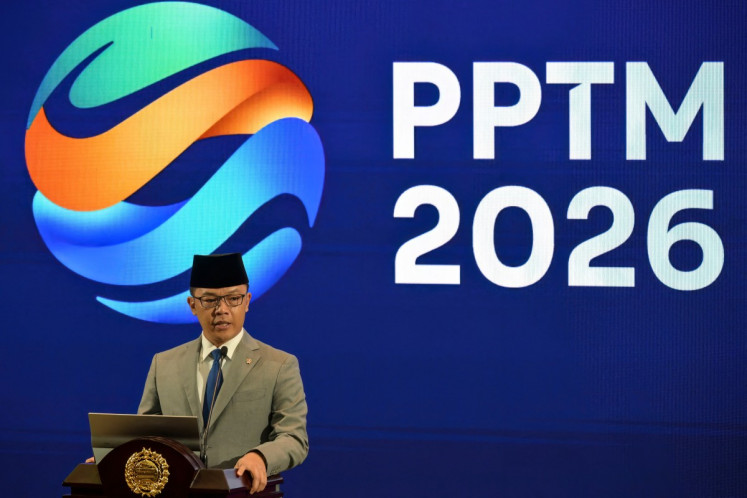Popular Reads
Top Results
Can't find what you're looking for?
View all search resultsPopular Reads
Top Results
Can't find what you're looking for?
View all search resultsFrench chocolate features Indonesian cacao beans
FRANCOIS PRALUS (JP/Leonard Pitt) A walk in Paris with Leonard Pitt is always a wonderful treat, and the other day it became a gastronomical one too
Change text size
Gift Premium Articles
to Anyone
FRANCOIS PRALUS (JP/Leonard Pitt)
A walk in Paris with Leonard Pitt is always a wonderful treat, and the other day it became a gastronomical one too.
The author of two Parisian walking-guides-with-a-difference, Pitt explores changes in the urban landscape and finds vestiges of buildings and streets, documenting them with old postcards, new photographs and historical details.
Pitt is also the founder of the Berkeley Chocolate Club.
When he suddenly stopped at 35 Rue Rambuteau and said, almost yelling, "Let's go inside, this is Pralus", I should have guessed that Pralus must be an excellent chocolatier.
The one we went into was the first Pralus shop in Paris.
Charismatic Fran*ois Pralus himself was present. Alongside the famous praline brioche made with pink almonds, invented by his father Auguste in 1948, the complete range of chocolate was there -- and being sold rapidly.
After Pralus and Pitt exchanged books, the discussion on chocolate began. Suddenly The Jakarta Post noticed that two bars on display were called, respectively, "Djakarta" and "Indonesie".
"Yes, they are made from Indonesian cacao beans, and also 'Melissa', which is a milk chocolate made of 45 percent criollo beans," Pralus said.
Indonesia is the world's second largest producer of cacao beans, accounting for 14 percent of world production or 580,000 tons, mainly from Java and Sulawesi.
Later, at a cocktail party for the opening of the shop, came the chance to taste a bar of "Indonesie". The result? A professional chocolate taster described it as tasting of orange peel, pure licorice and, finally, burned toffee. Yummy -- 75 percent dark chocolate made from East Javanese criollo beans.
Certainly a treat for the taste buds. Pralus deliberately roasts the beans until they achieve a more burnt caramel toffee taste than others.
So how did Pralus become a chocolatier?
"I began by working for my father between 1975 and 1976 in our fine bakery in Roanne. Then I was apprenticed to famous patissiers (pastry chefs) Bernachon in Lyon and Lenotre in Paris. Soon I was overcome by passion for chocolate."
Afterward, he worked abroad as a patissier and for Hotel Meridien in Nice, but then took over the family business in 1988 and began making chocolate in 1991.
Now Pralus is one of three French master chocolatiers who make their own chocolate directly from cacao beans. It is a fine art and he counts La Maison Troisgros, Guy Savoy, Pierre Gagnaire, Pierre Herme, Laduree and Le Grand Vefour among his faithful clients. Winning professional distinction has not stopped him from expanding the range produced in Roanne.
Pralus buys dried cacao beans from the most famous crus (vintages) from Central and South America, Indonesia and Ghana. He recently established a plantation in Madagascar where a strain of criollo cacao is cultivated. Criollo is the world's oldest cacao species, followed by trinitario and then forastero.
Based in Roanne, Central France, there is a team of 40 to help produce Pralus' edible delicacies, producing nearly 25 tons of chocolate bars a year. These are sold at selected outlets in France, London (Fortnum and Mason's), New York and Tokyo.
The enthusiastic chocolatier makes his own couverture chocolate, which forms the base of all his other chocolate.
"I make everything myself. To get an idea of the future flavor, I concoct some cacao with water, a sort of herb tea, add a whiff of sugar and let it settle. Then I can get a precise idea of what the aroma will be."
Meanwhile, we were being distracted by more chocolate. I tried "Djakarta", made of 75 percent Indonesian criollo and trinitario beans. More tart and reminiscent of buah merah (red fruit), it also revealed hints of smoky tea.
The "Melissa" milk chocolate, made of 45 percent criollo beans, was strong for a milk chocolate, with a caramelized nut taste. We did not taste the "Fortissima" chocolate bar, which is an 80 percent mixture of Indonesian criollo and trinitario beans from elsewhere, nor the 100 percent "Origin", truly for absolute fans.
My husband tried 75 percent "Venezuela"; his whispered verdict: "Sweeter than 'Indonesie' and it melts more."
When Pitt said it was unfortunate that the rich-flavored Vanuatu chocolate was no longer available, Pralus replied, "We tried to contact the plantation to no avail, but without beans from that Pacific island, sadly no chocolate."
The ancient Atzecs and Mayans from South America were the first to discover the virtues of cacao beans to brew a sacred beverage. Atzecs regarded the plant as being a holy gift from the goddess of fertility Xochiquetzal, from which the name "chocolate" is derived.
Much later, Anne of Austria introduced the hot beverage to France when she was betrothed to Louis XIII.
Chocolate contains caffeine, theobromine, vitamins A, B and E and polyphenols, together with a good portion of magnesium -- so no need to feel guilty about enjoying it, especially when you discover real chocolate such as that in Pralus, which is instantly gratifying.
Perhaps, someday, an Indonesian will create dark chocolate featuring chili, both indigenous products. There is already a Mexican chocolate chicken recipe and French chocolate-based cosmetics.










